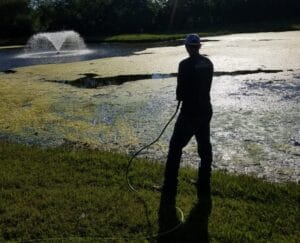Potamogeton is a group of aquatic plants that are found all over the world. Generally referred to as “pondweeds”, these plants thrive in all types of freshwater environments. The most common species of potamogeton found here in north Texas is called American pondweed (Potamogeton nodosus). It is a native plant that roots in shallow water and is characterized by blade shaped floating leaves. During the summer, a small seed head will protrude above the water’s surface on a small stalk.
American Pondweed is beneficial for gamefish
American pondweed is considered a desirable aquatic plant for several reasons. Primarily, the plant is beneficial to many types of wildlife. Ducks and other waterfowl love to eat potamogeton and fish use the vegetation as cover and prime foraging habitat. The floating canopy provides shade and cooler water for gamefish. The plant also creates prime breeding and nursery grounds for both largemouth bass and desirable sunfishes.

Desirable American Pondweed
The benefits of potamogeton do not end there. Healthy stands of American pondweed create a microenvironment rich in aquatic insects, frogs, and small fish. These critters help to reduce the numbers of both adult and larval mosquitoes. This is important since mosquito borne diseases are a sensitive issue in urban community ponds.
American Pondweed helps reduce algae growth
One of the lesser known benefits of potamogeton is that it has the ability to restrict the growth of unsightly and possibly harmful algae blooms. Since floating pondweeds typically grow in water depths of 3 feet or less, they occupy those areas where algae is most likely to establish. This is especially important in older storm-water ponds that have become silted in over time. American pondweed creates a more natural transition from the shoreline edge to the water’s surface. Without the presence of desirable vegetation, these transition areas tend to become occupied by hard to control algae species. Though undesirable algae can be controlled with chemicals, the effects are often short lived in these very shallow areas. Therefore, the presence of floating pondweed can reduce the frequency of algaecide applications required to maintain an aesthetically pleasing pond.
And finally, potamogeton acts as a filter to reduce excess nutrients that naturally enter the pond. Phosphorus is absorbed by the plant for growth and metabolic functions. These are the same nutrients that would otherwise be used in the production of undesirable algae species. Floating pondweed also offers some degree of bank stabilization and erosion control; though not as effective as emergent plants that are rooted along the shoreline.

Treating Undesirable Filamentous Algae in a Pond without Beneficial Aquatic Plants.
Keep all of this in mind before choosing to eradicate all aquatic weeds from your pond. Desirable plant coverage up to 20% of the pond surface is beneficial to your fish, wildlife and water quality. American pondweed will rarely expand beyond the shoreline perimeter, and it yields several benefits. However, if your pond is extremely shallow, it may require management using herbicides or triploid grass carp.
Read more about American pondweed here: https://aquaplant.tamu.edu/plant-identification/alphabetical-index/american-pondweed/
